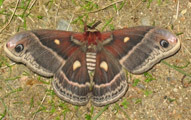Native Plants
Search for native plants by scientific name, common name or family. If you are not sure what you are looking for, try the Combination Search or our Recommended Species lists.
Morella pensylvanica
Morella pensylvanica (Mirb.) Kartesz
Northern Bayberry, Candleberry
Myricaceae (Bayberry Family)
Synonym(s): Myrica pensylvanica
USDA Symbol: MOPE6
USDA Native Status: L48 (N), CAN (N), SPM (N)
A spreading, much-branched shrub, usually 3-12 ft. tall. Glossy, fragrant gray-green, egg-shaped leaves remain on the plant in the southern part of its range, or turn tan-colored and persist into winter farther north. Green catkins appear before leaves. Clusters of small, round, hard, white berries remain on the female plant all winter.
Plant Characteristics
Duration: PerennialHabit: Shrub
Leaf Retention: Deciduous
Leaf Arrangement: Alternate
Leaf Complexity: Simple
Fruit Type: Drupe
Size Notes: Up to about 15 feet tall in ideal conditions, usually shorter.
Leaf: Green
Fruit: Bluish white.
Bloom Information
Bloom Color: Yellow , GreenBloom Time: Mar , Apr , May , Jun
Distribution
USA: CT , DC , DE , MA , MD , ME , NC , NH , NJ , NY , OH , PA , RI , VA , VTCanada: NB , NS , PE
Native Distribution: Along the coast from Nova Scotia to VA, inland to Ohio
Native Habitat: Ledges, wood borders; thickets
Growing Conditions
Water Use: MediumLight Requirement: Part Shade
Soil Moisture: Moist
Soil pH: Acidic (pH<6.8)
CaCO3 Tolerance: Medium
Soil Description: Clay, Loam, Sand
Conditions Comments: Bayberry tolerates salt spray and a wide variety of wet to dry, hot to cold growing conditions. Be sure to obtain plants similar to climatic condition in your garden. Both male and female plants are necessary for berries. From NJ to LA, another coastal bayberry occurs, M. heterophylla. It is similar with smaller fruits.
Benefit
Use Wildlife: Eaten by many winter birds.Attracts: Birds , Butterflies
Larval Host: Columbia silkmoth
Butterflies and Moths of North America (BAMONA)
|
Columbia silkmoth (Hyalophora columbia)  Larval Host |
Propagation
Description: Sow seed outdoors in the fall or stratify. Semi-hardwood cuttings root moderately will with hormone treatment.Seed Collection: Collect seeds in mid to late fall.
Commercially Avail: yes
Find Seed or Plants
View propagation protocol from Native Plants Network.
Mr. Smarty Plants says
Shrubs for playground barrier hedge in Darien CT
December 07, 2009
I am working on my Eagle Scout project which is a barrier hedge in front of a playground at our town's baseball field to protect the kids from getting hit by balls. The fence would be 4 feet tall an...
view the full question and answer
National Wetland Indicator Status
| Region: | AGCP | AK | AW | CB | EMP | GP | HI | MW | NCNE | WMVE |
| Status: | FAC | FAC | FAC | FAC |
From the National Organizations Directory
According to the species list provided by Affiliate Organizations, this plant is on display at the following locations:Native Plant Center at Westchester Community College, The - Valhalla, NY
Delaware Nature Society - Hockessin, DE
Mt. Cuba Center - Hockessin, DE
Bibliography
Bibref 1186 - Field Guide to Moths of Eastern North America (2005) Covell, C.V., Jr.Bibref 1185 - Field Guide to Western Butterflies (Peterson Field Guides) (1999) Opler, P.A. and A.B. Wright
Bibref 1620 - Gardening with Native Plants of the South (Reprint Edition) (2009) Wasowski, S. with A. Wasowski
Bibref 841 - Native Alternatives to Invasive Plants (2006) Burrell, C. C.
Search More Titles in Bibliography
Web Reference
Webref 38 - Flora of North America (2019) Missouri Botanical Garden, St. Louis, MO & Harvard University Herbaria, Cambridge, MA.Additional resources
USDA: Find Morella pensylvanica in USDA PlantsFNA: Find Morella pensylvanica in the Flora of North America (if available)
Google: Search Google for Morella pensylvanica
Metadata
Record Modified: 2023-04-18Research By: TWC Staff